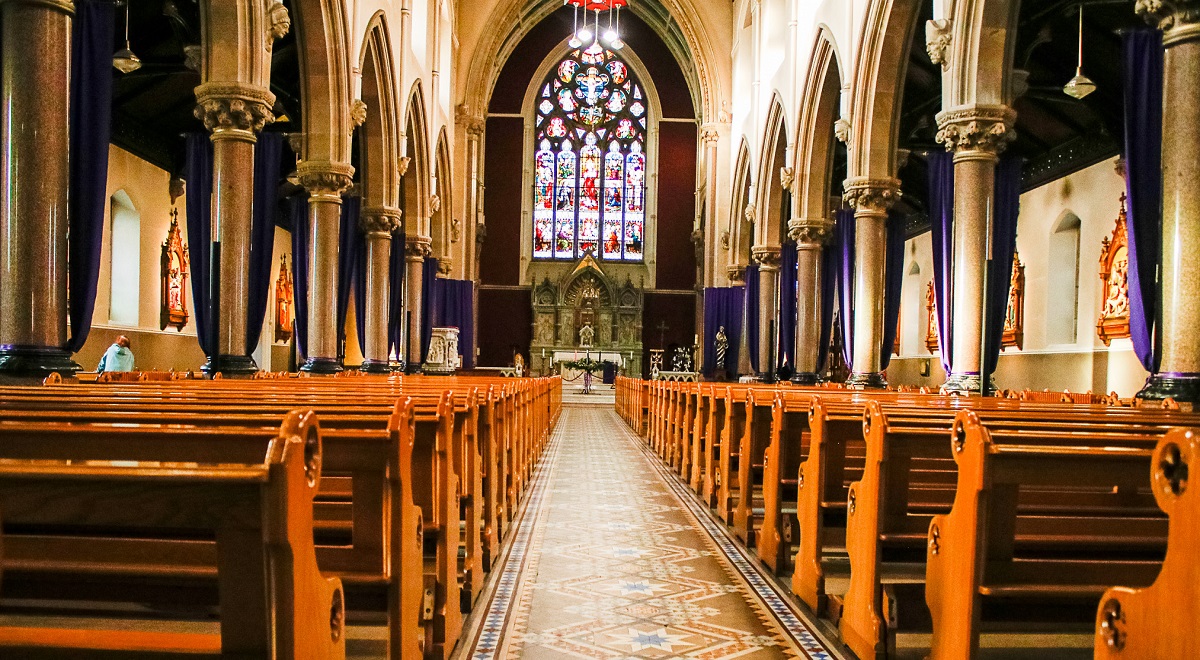There is one particular building that dominates the Omagh skyline: The Sacred Heart Church.
It consists of two spires; one slightly bigger than the other, which have stood tall over the town for more than 100 years.
Prior to the current site on Church Street, Catholicism in Omagh had two previous locations to celebrate Mass.
One site was on the Derry Road, described as a ‘plain unpretentious structure, capable of accommodating 400 people’ according to ‘Poetry in Stone’ – a book written to mark centenary of Sacred Heart Church by Rev Gerry Convery.
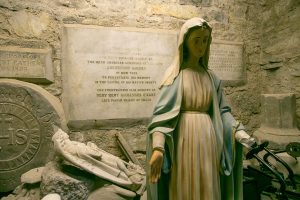
While another church was built at Brook Street in 1829, which could facilitate 1,500.
However, by 1899, the church (named St Peter’s and St Paul’s) had to close due to over-crowding (church authorities noted people kneeling outside),and the proximity to a hospital associated with cholera, of which moans of the dying could be heard during Mass.
Monsignor Bernard McNamee, a priest in the Brook Street church at the time, had an ambitious vision for a grandeur church building to dominate over the town of Omagh.
The contract was awarded to Joseph Colhoun of Strand Road in Derry for the primary plan of the building and roofing for the new site, and it was agreed in September 1892.
Another man by the name of William Hauge was appointed as the architect.
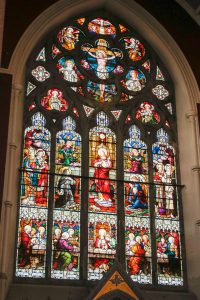
It is widely-believed that Hauge’s inspiration for Sacred Heart Church was heavily-influenced by the Notre Dame in France because of its beautiful gothic design.
Additionally, the different-sized spires, stained glass windows and sculpture figures are similar to the historic French cathedral.
According to ‘Poetry in Stone’, the proposed cost of the new church initially was ‘less than £20,000’, however this rose to £46,000 when all additions and sub-contracts were added.
This, in today’s value, would be more than seven million pounds.
Funding for the church had to start somewhere, and in the years to come, the committee would go to great lengths to manifest Monsignor McNamee’s vision.
Their first official meeting was held in 1889, with £10,000 already raised towards the construction of the new church.
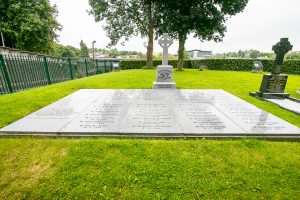
By the end of 1899, nearly £3,000 was raised on top of the £10,000 already in place.
In the following years, a multitude of fundraising campaigns and events were executed by the committee.
Mentioned in the early records of the church were donations from the president of St Vincent De Paul.
Furthermore, other donations came from many people from different denominations in Omagh through their subscription to the building fund.
In 1896, a concert was held at St Eugene’s temperance Hall on the Dromore Road, which saw a ‘densely packed’ crowd attend.
Numerous fund-raising bazaars were held throughout the years, with one notable bazaar held in 1896 at the Omagh Courthouse.
This bazaar raised over £2,200 through eight stalls, and many who won prizes generously returned them back to the church to be sold, and those proceeds went back into the church fund.
One priest took it upon himself to embark upon the long, dangerous journey to the United states ‘under the guidance of God’ to raise additional funds for the lords house in Omagh. This priest was Father JJ McGlade.
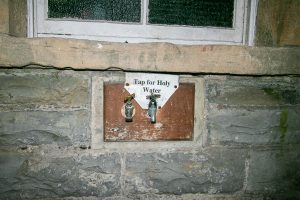
He was ordained at Maynooth in 1879, and came to Omagh for his first placement.
At this time, not much was known locally of the US, and to travel there was not as luxurious as today.
Instead of first class seats on a plane for a 13 hour flight, the best option was six months in cramped and unhygienic conditions at sea, with a high-risk of death from catching contagious diseases.
Yet, the desire for the new church was strong enough that Fr McGlade took the foreboding journey in 1890 in the name of religious pursuit.
In his expedition, he travelled more than 40,000 miles between America and Canada, and met many individuals and groups with Tyrone and Irish connections who happily donated to this Omagh cause.
He arrived back in 1895, not only with a large sum of money, but also with two priests and a layman for the aid of construction.
It is not known how much Fr McGlade raised exactly, but the mission was noted as being ‘very successful’.
Starting in 1893 with a ceremony for laying the foundation stone, the construction was no easy task, and perfection was the only option.
The church informally-opened in 1899 pending consecration (and a second spire).
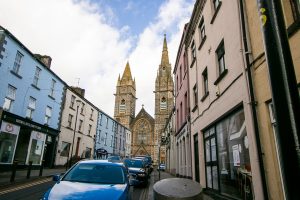
Throughout its near 125 years of service, the church would take on many changes and upgrades.
The second spire was completed some time after 1905, though it is not clear when.
In 1929, parish priest, Dr McShane, made an appeal for donations to repair the church, and he received a ‘most generous response’, which allowed repairs to the roof and two new confessional boxes.
In more recent times, a refurbishment was launched in 1995 with stronger roof fixtures and waterproof materials, and would finish just a week after the Omagh bomb attack.
Today, Mass continues to be celebrated in this magnificent building, which has recorded over a century of local births, funerals, confessions, communions and confirmations.
Did You Know?
- When the church opened in 1899, it only had one spire completed.
- Dr Treanor promised the committee he would donate £500, a big amount for that time. Treanor announced his contribution of generosity from the altar, but had only paid £300 before his sudden death.
- Though the church was finished in 1899, the consecration would not take place until 56 years later. This is due to Church Law, which dictates that a church is not the work of God until all debt is paid off.
- The church bell and Pietà (the statue of dying Jesus in the arms of Mary) are original to the first Brook Street church.
- Up to five unfortunate souls lost their lives during the construction of the church.
- The stations of the cross are in the wrong order! Many years ago the framed depictions were taken down for cleaning, and whoever left them back up didn’t pay attention to the order of the story.
- Hugh McCann, who was the ‘superintendent’ of the construction, worked hard through the 1890s and lived to an impressive age of 96.
- The church was electrified in 1935, it had previously been lit with gas fixtures but had become ‘noisy and bubbly’.
- During the refurbishment in 1995, Stephen Managan, a workman, found a doll house made from left-over wood by a bored labourer during the original construction of the roof.
- The church’s handbell, known as the ‘clog dubh’ or ‘the McEnhill bell’ was entrusted to the parish by James McElhill sometime in the 1930s
- There are 14 heads of saints dotted around the church, including St Dympna, St Columba, St Patrick, St Bridgid, and many more.
- In the corners of the three doors entering the church there are eight various statues of flowers, fruit and crops with different meanings;
Shamrock – represents the Holy Trinity.
Lily – represents St Joseph, Patron of the church and purity.
Ivy – Symbolises fidelity.
Wheat – represents the Eucharist.
Grapes – represents the wine for the Blood of Christ.
Oak Leaves – For the diocese of Derry. Doire is the Irish word for Derry which means ‘oak grove’.
Rose and Thistle – Acknowledges the contributions from England and Scotland.
Passion Flower – Priests in the 1500s discovered this flower in Latin America and named it for the passion (suffering and death) of Christ.
–






